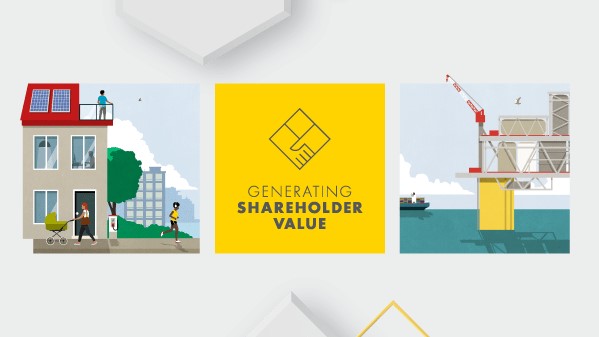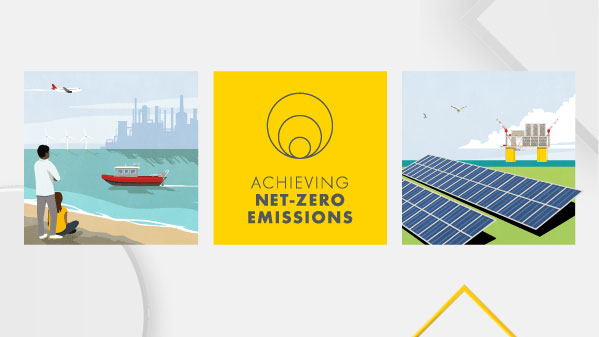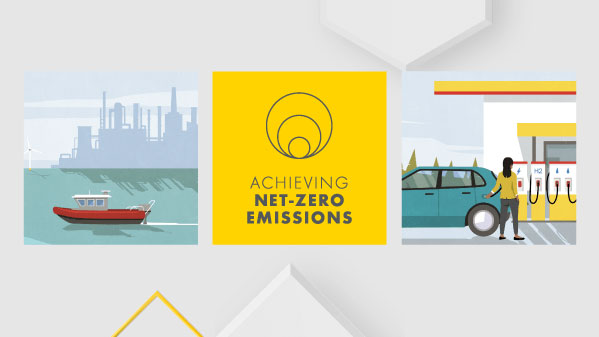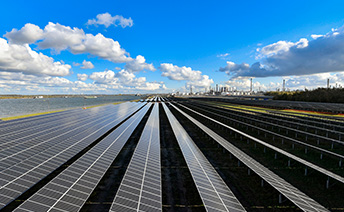Business Council of Australia (BCA)
BCA represents Australia’s largest employers.[1] Members represent sectors including mining, energy, retail, manufacturing, infrastructure, information technology, financial services and banking, professional services, transport and telecommunications.[2]
Membership of board/executive committee: None
- 2022 assessment outcome: Aligned
- 2021 assessment outcome: Aligned
Summary
Shell benefits from its membership of BCA, which provides an important platform to engage with businesses in Australia on taxes, climate policy and other issues. BCA is a member of the Australian Climate Roundtable and signatory to its joint principles for climate policy.[3]
We welcome the BCA’s Achieving Net Zero paper that it published in October 2021, that underpinned much of its advocacy in 2022, and the proactive and constructive approach it has taken to advocating for Australian climate policy.
We have found BCA to be aligned with our climate and energy transition-related policy positions.
We will remain a member of BCA. We will continue to engage the association on climate and energy transition topics. We will continue to track alignment between BCA’s climate and energy transition-related positions and our own.
Further information
Click on the sections below to read more.
Paris Agreement and net-zero emissions
- BCA has stated support for transitioning to net-zero emissions by 2050.[4] [5] BCA has also stated support for the temperature goal of the Paris Agreement.[6]
- In its October 2021 paper Achieving a net zero economy, BCA states that “we must limit global average warming to as close to 1.5°C by 2050 and below 2°C, in alignment with current Paris Agreement objectives.”[7] In the report, BCA stated that “an economy-wide ambition to lift the 2030 emissions reduction target to a range of 46 to 50 per cent below 2005 levels is achievable.”[8]
- In 2022, BCA stated support for the government’s Climate Change Bill 2022.[9] BCA is part of the Joint Australian Climate Roundtable, which also stated support for the Climate Change Bill.[10]
Carbon pricing
- In its October 2021 paper, Achieving a net zero economy, BCA states that “an explicit, economy-wide carbon pricing mechanism is the Business Council’s preferred option” but that “it is by no means the only workable option.”[11] It states: “Under our proposed policy architecture, the Safeguard Mechanism — supported by the Climate Solutions Fund, a robust domestic offsets market and a fit-for-purpose innovation and technology strategy — is the principal vehicle for creating a carbon investment signal to achieve national emission targets and budgets out to 2050.”[12] In its 2022 response to the Australian government’s consultation on reforms to the Safeguard Mechanism, BCA stated support for the Safeguard Mechanism, and set out a number of areas for further consideration. These included crediting and trading as an additional option for safeguard facilities to meet their compliance obligations, inclusion of Paris-compliant international units and resetting baselines in a way that removes aggregate headroom.[13]
Energy efficiency
- BCA has stated support for improving energy efficiency through standards and regulatory instruments in different sectors.[14] In its October 2021 paper, Achieving a net zero economy, BCA has stated that during the period 2021-30, Australia should focus on easy-to-abate industries and sectors, including improvements in small- and large-scale energy efficiency and introduce a “targeted white certificate energy efficiency scheme for low income households” and “performance-based incentives for home and building owners investing in energy efficiency”.[15]
Decarbonised hydrogen
- BCA has stated support for policies that enable investment in different forms of decarbonised hydrogen.[16] In its October 2021 paper, Achieving a net zero economy, BCA states that green hydrogen and blue hydrogen are two technologies that could be developed and deployed for hard-to-abate sectors.[17] It states “develop and implement a renewable gas target to facilitate the commercialisation of zero emission gases such as hydrogen and biomethane” and notes the export opportunities for Australia-produced hydrogen.[18]
Natural ecosystems
- In its October 2021 paper, Achieving a net zero economy, BCA states that “scientific assessments estimate that agricultural land in Australia has significant potential to store carbon, and to mitigate and offset emissions over coming decades. […] Subject to development of the necessary international trading frameworks under the Paris Agreement, some of this potential supply could conceivably be exported in the future.”[19]
Carbon capture and storage
- BCA has stated the need for the large-scale deployment of carbon capture and storage (CCS) for hard-to-abate sectors and industries.[20] In its October 2021 paper, Achieving a net zero economy, BCA states that CCS in industrial processes will be important for meeting the 2030 emissions reduction target, and highlights Australia’s geological structures necessary for CCS.[21]
Environmental, social and governance (ESG) standards and benchmarks, sustainable finance taxonomies
- In its October 2021 paper, Achieving a net zero economy, BCA stated that business has to “review, respond and fully report on their climate risk in accordance with the Task Force on Climate-related Financial Disclosures (TCFD) guidance”.[22]
- In 2021, BCA responded to the government’s consultation on the Corporate Emissions Reduction Transparency (CERT) report and guidelines. BCA raised similar concerns to Shell regarding some challenges with the design of the scheme and how reporting would work in practice, especially for multinationals. BCA provided general support for the intent of the scheme, as did Shell.[23]
- BCA has not stated a position on sustainable finance taxonomies.
Coal
- In its October 2021 paper, Achieving a net zero economy, BCA highlighted an Energy Security Board statement that a fit-for-purpose national electricity market design needs to be “prepared for old coal retirement, whilst maintaining resource adequacy as aging thermal generators exit”.[24] The paper references the significant declines in demand for thermal coal, oil and natural gas projected in IEA’s May 2021 report and states “given Australia’s high exposure to fossil fuels, this reduction will have a significant impact on the market for Australian exports.” It also states “Thermal coal falls by 90 per cent by 2050 (from 2020).”[25]
Electrification with renewable or low-carbon power
- BCA has stated support for increased electrification and decarbonisation of the electricity grid.[26] [27] In its October 2021 paper, Achieving a net zero economy, BCA includes electrification as a key solution within Australia’s net-zero transition timeline, and states “renewable electricity generation is currently responsible for about 25 per cent of the NEM’s [National Electricity Market] total annual output and 28 per cent of total national electricity output. A net zero emissions electricity sector requires this percentage to approach 90 to 95 per cent.”[28]
- In its 2022 response to the Australian government’s consultation on reforms to the Safeguard Mechanism, BCA states that “a nationally integrated policy approach to supporting investment in renewables and firming capacity in response to changing market dynamics – including incumbent asset closures and international energy market disruptions – is vital to broader climate policy success.”[29]
Gases and methane
- In its October 2021 paper, Achieving a net zero economy, BCA stated that natural gas “will have a critical ‘enabling’ role to play in the transition to net zero by 2050, and renewable gas will be part of the decarbonised energy mix in the future”.
- BCA has not stated a position in support of direct regulation of methane emissions or ending routine flaring by 2030 or sooner.
Road transport: Passenger cars and vans
- In its October 2021 paper, Achieving a net zero economy, BCA stated that policy incentives “to accelerate the uptake of low and zero emission vehicles are needed to create cost parity with internal combustion vehicles” and that a “national government-led transition plan is needed to coordinate the widespread roll-out of state-of-the-art low and zero emission vehicle charging infrastructure across Australia over time.”[30]
- In its 2022 response to the Australian government’s consultation on the National electric vehicle strategy, BCA stated support for the strategy and set out a number of recommendations.[31] BCA did not respond to the government’s question about timeframes for incentivising low-emission vehicles.[32]
Road transport: Heavy-duty vehicles
- In its October 2021 paper, Achieving a net zero economy, BCA stated support for incentivising “fuel switching of heavy vehicles, such as hydrogen fuel cell trucks and other vehicles, in the resources, construction, transport and agricultural sectors”. It also recognised the need for low-carbon regional roadmaps.[33]
Heavy industry decarbonisation
- In its October 2021 paper, Achieving a net zero economy, BCA stated support for “supply and demand side policy incentives to facilitate the development and deployment of emissions reduction technologies specifically applicable to Australia’s manufacturing, energy and mining operations” and set out a number of policy recommendations.[34] It also stated support for the “development of a national climate-ready manufacturing strategy for the 21st century that aligns with the Modern Manufacturing Strategy and focus on targeting regional Australia”.[35]
Aviation
- In its October 2021 paper, Achieving a net zero economy, BCA stated that “a comprehensive suite of policies should be developed with industry and implemented in order to set an ambitious domestic SAF production target” and that the best ideas should be sought from industry “on how to meet such targets and implement targeted subsidies, incentives, grants, loan guarantees and tax credits to support further R&D, feedstock development and domestic production of SAF at a commercial scale/viable price”.[36] It also stated that the aviation sector needs access to more Australian carbon credits at commercially reasonable prices if it is to meet its decarbonisation commitments.[37]
Shipping
No position
Return to list of associations[1] https://www.bca.com.au/about
[2] https://www.bca.com.au/membership
[3] https://www.australianclimateroundtable.org.au/wp-content/uploads/2020/11/Climate_roundtable_joint_principles-Updated_November_2020.pdf
[4] https://www.bca.com.au/our_work
[5] https://d3n8a8pro7vhmx.cloudfront.net/bca/pages/6612/attachments/original/1633693581/BCA_Achieving_a_net_zero_economy_-_9_October_2021.pdf?1633693581)
[6] https://d3n8a8pro7vhmx.cloudfront.net/bca/pages/6612/attachments/original/1633693581/BCA_Achieving_a_net_zero_economy_-_9_October_2021.pdf?1633693581
[7] https://d3n8a8pro7vhmx.cloudfront.net/bca/pages/6612/attachments/original/1633693581/BCA_Achieving_a_net_zero_economy_-_9_October_2021.pdf?1633693581
[8] https://d3n8a8pro7vhmx.cloudfront.net/bca/pages/6612/attachments/original/1633693581/BCA_Achieving_a_net_zero_economy_-_9_October_2021.pdf?1633693581
[9] https://www.bca.com.au/certainty_will_let_businesses_drive_the_transition
[10] https://www.aigroup.com.au/globalassets/news/submissions/2022/australian_climate_roundtable_climate_change_bills_august_2022.pdf
[11] https://d3n8a8pro7vhmx.cloudfront.net/bca/pages/6612/attachments/original/1633693581/BCA_Achieving_a_net_zero_economy_-_9_October_2021.pdf?1633693581
[12] https://d3n8a8pro7vhmx.cloudfront.net/bca/pages/6612/attachments/original/1633693581/BCA_Achieving_a_net_zero_economy_-_9_October_2021.pdf?1633693581
[13] https://assets.nationbuilder.com/bca/pages/6928/attachments/original/1665371161/Submission_-_Business_Council_of_Australia.028193bff73dd.pdf?1665371161
[14] https://d3n8a8pro7vhmx.cloudfront.net/bca/pages/6612/attachments/original/1633693581/BCA_Achieving_a_net_zero_economy_-_9_October_2021.pdf?1633693581
[15] https://d3n8a8pro7vhmx.cloudfront.net/bca/pages/6612/attachments/original/1633693581/BCA_Achieving_a_net_zero_economy_-_9_October_2021.pdf?1633693581
[16] https://d3n8a8pro7vhmx.cloudfront.net/bca/pages/6612/attachments/original/1633693581/BCA_Achieving_a_net_zero_economy_-_9_October_2021.pdf?1633693581
[17] https://d3n8a8pro7vhmx.cloudfront.net/bca/pages/6612/attachments/original/1633693581/BCA_Achieving_a_net_zero_economy_-_9_October_2021.pdf?1633693581
[18] https://d3n8a8pro7vhmx.cloudfront.net/bca/pages/6612/attachments/original/1633693581/BCA_Achieving_a_net_zero_economy_-_9_October_2021.pdf?1633693581
[19] https://d3n8a8pro7vhmx.cloudfront.net/bca/pages/6612/attachments/original/1633693581/BCA_Achieving_a_net_zero_economy_-_9_October_2021.pdf?1633693581
[20] https://d3n8a8pro7vhmx.cloudfront.net/bca/pages/6612/attachments/original/1633693581/BCA_Achieving_a_net_zero_economy_-_9_October_2021.pdf?1633693581
[21] https://d3n8a8pro7vhmx.cloudfront.net/bca/pages/6612/attachments/original/1633693581/BCA_Achieving_a_net_zero_economy_-_9_October_2021.pdf?1633693581
[22] https://d3n8a8pro7vhmx.cloudfront.net/bca/pages/6612/attachments/original/1633693581/BCA_Achieving_a_net_zero_economy_-_9_October_2021.pdf?1633693581
[23] https://www.cleanenergyregulator.gov.au/Infohub/consultation-hub/corporate-emissions-reduction-transparency-report
[24] https://d3n8a8pro7vhmx.cloudfront.net/bca/pages/6612/attachments/original/1633693581/BCA_Achieving_a_net_zero_economy_-_9_October_2021.pdf?1633693581
[25] https://d3n8a8pro7vhmx.cloudfront.net/bca/pages/6612/attachments/original/1633693581/BCA_Achieving_a_net_zero_economy_-_9_October_2021.pdf?1633693581
[26] https://d3n8a8pro7vhmx.cloudfront.net/bca/pages/6612/attachments/original/1633693581/BCA_Achieving_a_net_zero_economy_-_9_October_2021.pdf?1633693581
[27] https://assets.nationbuilder.com/bca/pages/6928/attachments/original/1665371161/Submission_-_Business_Council_of_Australia.028193bff73dd.pdf?1665371161
[28] https://d3n8a8pro7vhmx.cloudfront.net/bca/pages/6612/attachments/original/1633693581/BCA_Achieving_a_net_zero_economy_-_9_October_2021.pdf?1633693581
[29] https://assets.nationbuilder.com/bca/pages/6928/attachments/original/1665371161/Submission_-_Business_Council_of_Australia.028193bff73dd.pdf?1665371161
[30] https://d3n8a8pro7vhmx.cloudfront.net/bca/pages/6612/attachments/original/1633693581/BCA_Achieving_a_net_zero_economy_-_9_October_2021.pdf?1633693581
[31] https://assets.nationbuilder.com/bca/pages/7032/attachments/original/1667195116/BCA__Submission_-_National_Electric_Vehicles_Strategy.pdf?1667195116
[32] https://assets.nationbuilder.com/bca/pages/7032/attachments/original/1667195116/BCA__Submission_-_National_Electric_Vehicles_Strategy.pdf?1667195116
[33] https://d3n8a8pro7vhmx.cloudfront.net/bca/pages/6612/attachments/original/1633693581/BCA_Achieving_a_net_zero_economy_-_9_October_2021.pdf?1633693581
[34] https://d3n8a8pro7vhmx.cloudfront.net/bca/pages/6612/attachments/original/1633693581/BCA_Achieving_a_net_zero_economy_-_9_October_2021.pdf?1633693581
[35] https://d3n8a8pro7vhmx.cloudfront.net/bca/pages/6612/attachments/original/1633693581/BCA_Achieving_a_net_zero_economy_-_9_October_2021.pdf?1633693581
[36] https://d3n8a8pro7vhmx.cloudfront.net/bca/pages/6612/attachments/original/1633693581/BCA_Achieving_a_net_zero_economy_-_9_October_2021.pdf?1633693581
[37] https://d3n8a8pro7vhmx.cloudfront.net/bca/pages/6612/attachments/original/1633693581/BCA_Achieving_a_net_zero_economy_-_9_October_2021.pdf?1633693581










